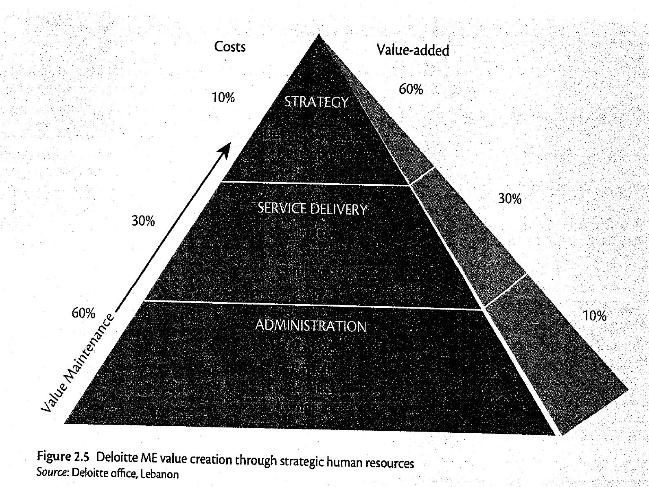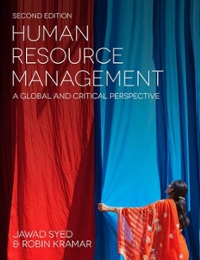The Deloitte Middle East Firm (Deloitte ME) is a member of the global professional services firm Deloitte
Question:
The Deloitte Middle East Firm (Deloitte ME) is a member of the global professional services firm Deloitte Touche Tohmatsu, which employs 169,000 people in 140 countries and had revenues of US \(\$ 27\) billion in the 2009 fiscal year. Deloitte ME is one of the longest established professional services firms in the region and has been operating since 1926 in 15 countries with 26 offices and a team of over 2,300 professionals. It has enjoyed a compounded revenue growth rate of 31 per cent in the region over the three years to 2010.
This case study is based on several rounds of interviews with Mrs Rana Ghandour Salhab, the first woman admitted as partner in the Middle East in the 80-year history of the firm in the region. She is currently the partner in charge of human resources and communications in the Middle East and a member of the Deloitte ME Board Advisory Council and the Deloitte ME Partner Screening Committee. It is worth noting that, in April 2009, Deloitte ME was recognised as one of the 10 best employers in the Middle East by Hewitt Associates, the global human resources consulting firm that runs best employer surveys across the world.
Based on a recent survey asking Deloitte employees what they expect from their employer, Deloitte ME adopted a 'develop, deploy, and connect' model as a talent strategy and a Career Value Map tool to reinforce the steps that individuals can take to own their careers and leverage Deloitte's resources and tools within each of the model areas. According to Mrs Salhab, organisations can, by focusing on these three elements, generate capability, commitment, and alignment in key workforce segments (Figure 2.4), which in turn improvesbusiness performance: 'When this happens, the attraction and retention of skilled talent largely take care of themselves'.
Deloitte has an interesting regional Talent Attraction Program and e-recruitment, revolving around a Middle East referral scheme, university relationships, an alumni and experienced hire programme, supplier relations, web and social networks sourcing, and Google ad words. The Deloitte Invites Top Talent programme also aims to attract top students from leading universities around the region to source offices with nationals of the Gulf Cooperation Council and Arabic-speaking professionals. The company's screening techniques focus on assessment centres, competency-based behavioural interviewing, psychometric testing, and a global development programme for its workforce.

The Deloitte performance management system is the key development employee tool, with a technical and shared skills competency model that facilitates year round career conversations and a coaching culture. Through the ME Deloitte Retention and Advancement for Women Program, the firm is committed to creating an environment where high achieving women and men both reach leadership roles.
Deloitte ME has been striving for a balance between a strategic human resources agenda with a long-term impact and operational day-to-day human resources activities. The company realises that the drivers and challenges for the business are transitioning the core efforts of human resources towards providing the business with a competitive advantage. This will happen by moving away from a focus on administration (for example, payroll, benefits, compliance, and record-keeping), or what they refer to as value maintenance, to a focus on value creation through the selection and design of human resources practices that support the firm's strategy (Figure 2.5). Mrs Salhab recognises that assuming the human resources partner role depends on the level of maturity of the organisation; it also illustrates nicely how the Deloitte ME function has made a successful transition from roles revolving around analyst and advisor to human resources roles entailing effective advocacy and partnering. This transformation has, according to Mrs Salhab, required a proactive approach combining flexible and specialist human resources orientations, combined with the redirecting of administration queries and a more active involvement of line managers in different sorts of people management activities.

Mrs Salhab admits that the transformation of human resources into strategic roles is not always easy and may in some companies be typically undermined by a number of risks and pitfalls that have to be avoided. These may be, for example: reduced client satisfaction (in the sense that a one-size-fits-all approach to service delivery may not recognise the diversity of employees);
- insufficient market insight into and innovation in human resources policies;
- low morale in human resources, with no clear career path or longer-term development programme for some human resources professionals;
- overly expensive running costs and poor-quality outsourcing contracts; - ineffective human resources business partners who are unable and ill-equipped to deliver the level of business advice expected; - a continued erosion of data quality, and therefore human resources credibility, as a result of poorly constructed processes;
- dissatisfaction with self-service technologies due to their low-quality implementation and the poor education of line managers.
These failings have led the business to question whether human resources is best placed to fix the issues or whether the business itself should take control and address them. Mrs Salhab also admits that, despite the global change in paradigms of SHRM, human resources professionals are still spending too much time on lowimpact activities (for example, responding to queries, responding to complaints, enforcing policies, managing conflicts, and basic administrative transactions) as opposed to forging strategy, developing metrics, and nurturing talent and leaders.
According to Mrs Salhab, human resources cannot just become strategic overnight. They have to drive a strategic agenda around things that matter, strengthen leadership capability, create an adaptable workforce, and advise on strategies that can maintain and enhance performance. This requires a number of key organisational and cultural changes that need to be crafted together, revolving around establishing the role of the chief human resources officer, optimising shared service centres, measuring success through value operation centres, and freeing business partners and the chief human resources officer to reflect the strategic focus. Other important changes revolve around adjusting human resources strategies to respond to changing needs, identifying critical human resources metrics and business strategies, identifying talent issues and prioritising human resources needs, redesigning structures around strategic objectives and, importantly, understanding the talent needs of the business. In this context, the onus also falls on human resources to nurture the right skills and competencies, including, among others, the following:
- behavioural competencies as in leadership skills, negotiation and conflict resolution, change leadership and communication skills;
- technical competencies, as in functional human resources knowledge, project management and the management of strategic resources;
- business competencies, as in business acumen, industry and organisational awareness, strategy and business planning, and consulting skills.
In conclusion, for Mrs Salhab, human resources is clearly at a turning point. For a decade now, it has been undergoing a process of transformation. But for many, this has been a process that has increasingly failed to produce the results expected of it: 'During these times of rapidly changing economics, we believe human resources is faced with a stark choice. It can either evolve and make a significant contribution, or be diminished and dispersed in the business.'
Questions
1 Mrs Salhab stated that 'During these times of rapidly changing economics, we believe human resources is faced with a stark choice. It can either evolve and make a significant contribution, or be diminished and dispersed in the business.' Use Figures 2.4 and 2.5 to explain how the human resources department at Deloitte adds value to the business.
2 Mrs Salhab is the first woman admitted as a partner in the Middle East in the 80-year history of the firm in the region. What additional challenges and opportunities can this provide for the successful development of the human resources department?
3 Do some further research and investigate whether the same human resources practices and policies are applied at Deloitte in various regions of the world. What lessons can you draw?
Step by Step Answer:

Human Resource Management A Global And Critical Perspective
ISBN: 9781137521620
2nd Edition
Authors: Jawad Syed, J; Kramar Syed, Robin Kramar





